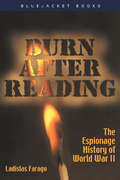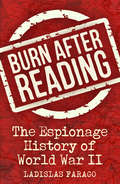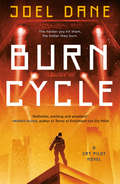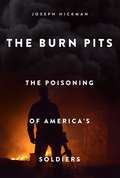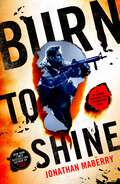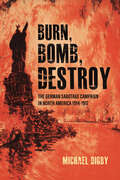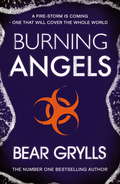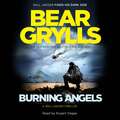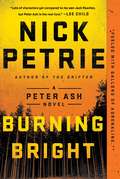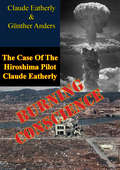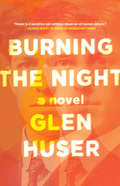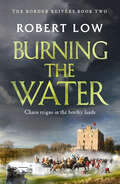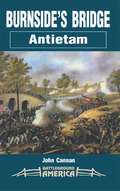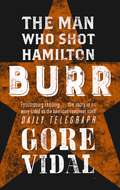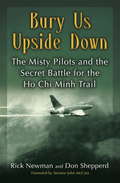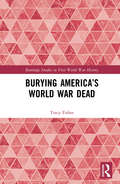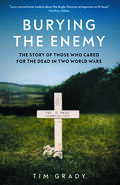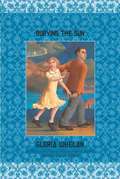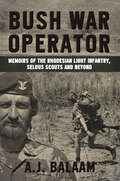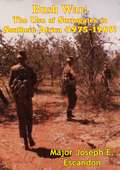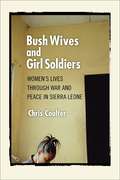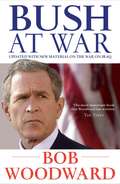- Table View
- List View
Burma: The Turning Point
by Maj. Gen. Ian Lyall GrantThe turning point of the war in Burma was the Imphal/Kohima campaign of 1944. For four months there was intense and savage fighting. The Japanese plan was to encircle and destroy the British and Indian positions before bursting into the plain and seizing Imphal. They failed in their first aim but the Japanese 15th Army prepared a final all-out thrust for Imphal. However, the British 4th Corps struck first and, after three weeks, the Japanese were virtually annihilated. This graphic account expertly analyses the campaign.
Burn After Reading
by Ladislas FaragoFought under the cover of elaborate deceptions and ruthless lies, the deadly intelligence operations of World War II produced victories and defeats that were often as important as any reached on the battlefield. A behind-the-scenes history of the war, this book offers an exciting picture of the whole range of clandestine activities, the various forms of intelligence, espionage and sabotage, subversion and counter-espionage--the entire secret war conducted apart from conventional warfare. The major exploits of the O.S.S., M.I.5, Abwehr, and the Deuxieme Bureau are described in colorful detail by an author considered one of the foremost civilian experts on intelligence during the war. Ladislas Farago's account of Allied and Axis spymasters at work offers compelling reading about real traitors and heroes in cloak-and-dagger-dom.
Burn After Reading: The Espionage History Of World War Ii
by Ladislas Farago Emerson F. HurleyBurn After Reading, first published in 1961, is an insider's look at the use of intelligence, espionage, and sabotage during the Second World War. Author Ladislas Faragó, chief of research and planning in the U.S. Navy's Special Warfare Branch, describes activities of the Allies' organizations (such as the O.S.S., M.I.5, Deuxième Bureau, various units in the Soviet Union, and others), as well as those of Germany and Japan. Many of the secret operations were critical to the success or failure of the war effort, and a high price was paid in terms of human lives lost as many spies and agents were captured, tortured, and executed. Hungarian-born Ladislas Faragó wrote numerous books on the war and espionage, including an authoritative biography of General George Patton (1963). Faragó passed away on October 15, 1980.
Burn Cycle (Cry Pilot #2)
by Joel DaneAn unbeatable enemy. A planet on the brink. And a squad with a taste for revenge. In this incendiary new military science fiction novel, an infantry squad crisscrosses the globe on a search-and-destroy mission against a relentless foe.After cry pilot Maseo Kaytu's white-knuckled victory over the mysterious lampreys at Ayko Base, military command develops new weapons and a new strategy. The updated mission is simple: pinpoint the Hatchery, the &“spawn point&” of the lampreys, and blast it into a fine powder. Kaytu's battle-tested squad tracks the enemy from remote bases to elegant cities to subterranean caverns, but the lampreys start hitting harder and faster. While the squad is winning battles, Earth is losing the war. When the search for the Hatchery shines a light on Kaytu's insurgent past, he faces a terrible truth. There is no line he won't cross to protect his squad. Then a vicious counterattack teaches him another lesson: you can't save everyone. In the end, all you can do is the job.
Burn Pits: The Poisoning of America's Soldiers
by Jesse Ventura Joseph HickmanThousands of American soldiers are returning from the battlefields of Iraq and Afghanistan with severe wounds from chemical war. They are not the victims of ruthless enemy warfare, but of their own military commanders. These soldiers, afflicted with rare cancers and respiratory diseases, were sickened from the smoke and ash swirling out of the burn pits where military contractors incinerated mountains of trash, including old stockpiles of mustard and sarin gas, medical waste, and other toxic material. Based on thousands of government documents, over five hundred in-depth medical case studies, and interviews with more than one thousand veterans and active-duty GIs, "The Burn Pits" will shock the nation. The book is more than an explosive work of investigative journalismit is the deeply moving chronicle of the many young men and women who signed up to serve their country in the wake of 9/11, only to return home permanently damaged, the victims of their own armed forces criminal negligence. "
Burn to Shine: A Joe Ledger and Rogue Team International Novel (Rogue Team International Series)
by Jonathan MaberryRogue Team International joins Joe Ledger in a new, tension-filled mission to stop a wave of bioterrorism from devastating the country in the fourth installment of bestselling author Jonathan Maberry's ongoing series.A covert group is infiltrating the world’s most secure bio-weapons research sites. All across the country, people are acting as human ‘disease bombs’ by infecting themselves and walking into public places. And heavily-armed groups of illegal private soldiers are massing for some unknown strike.Joe Ledger and the members of Rogue Team International, still reeling from the devastation and heartbreaking losses of their last mission, are forced into relentless action to try and save the country, if not the entire world.Old enemies are rising and joining forces to hit Joe and his team with one devastating blow after another. What is the end game for all of this madness and terror? Outnumbered, outmaneuvered, and outgunned, Joe Ledger has to find a way back from the fires of grief in order to make a stand between these enemies and millions of potential innocent lives. But Joe has allies, too. His team, the vicious fighters of Arklight, and friends who may or may not be entirely human.A war of darkness and light is coming. Who will stand? Who will fall? And how will anyone ever survive?
Burn, Bomb, Destroy: The German Sabotage Campaign in North America, 1914–1917
by Michael DigbyMany believe that World War I was only fought "over there," as the popular 1917 song goes, in the trenches and muddy battlefields of Northern France and Belgium—they are wrong. There was a secret war fought in America; on remote railway bridges and waterways linking the United States and Canada; aboard burning and exploding ships in the Atlantic Ocean; in the smoldering ruins of America's bombed and burned-out factories, munitions plants, and railway centers; and waged in carefully disguised clandestine workshops where improvised explosive devices and deadly toxins were designed and manufactured. It was irregular warfare on a scale that caught the United States woefully unprepared. This is the true story of German secret agents engaged in a campaign of subversion and terror on the American homeland before and during World War I.
Burning Angels
by Bear GryllsA prehistoric corpse entombed within an Arctic glacier, crying tears of blood.A jungle island overrun by rabid primates - escapees from a research laboratory's Hot Zone.A massive seaplane hidden beneath a mountain, packed with a Nazi cargo of mind-blowing evil.A penniless orphan kidnapped from an African slum, holding the key to the world's survival.Four terrifying journeys. One impossible path. Only one man to attempt it.Will Jaeger. The Hunter.
Burning Angels
by Bear GryllsA prehistoric corpse entombed within an Arctic glacier, crying tears of blood.A jungle island overrun by rabid primates - escapees from a research laboratory's Hot Zone.A massive seaplane hidden beneath a mountain, packed with a Nazi cargo of mind-blowing evil.A penniless orphan kidnapped from an African slum, holding the key to the world's survival.Four terrifying journeys. One impossible path.Only one man to attempt it. Will Jaeger. The Hunter.Read by Rupert Degas(p) 2016 Orion Publishing Group
Burning Bright (A Peter Ash Novel #2)
by Nick Petrie“LOTS OF CHARACTERS GET COMPARED TO MY OWN JACK REACHER, BUT PETRIE'S PETER ASH IS THE REAL DEAL.”—Lee ChildIn the new novel featuring war veteran Peter Ash, “an action hero of the likes of Jack Reacher or Jason Bourne” (Lincoln Journal-Star), Ash has a woman’s life in his hands—and her mystery is stranger than he could ever imagine. War veteran Peter Ash sought peace and quiet among the towering redwoods of northern California, but the trip isn’t quite the balm he’d hoped for. The dense forest and close fog cause his claustrophobia to buzz and spark, and then he stumbles upon a grizzly, long thought to have vanished from this part of the country. In a fight of man against bear, Peter doesn’t favor his odds, so he makes a strategic retreat up a nearby sapling. There, he finds something strange: a climbing rope, affixed to a distant branch above. It leads to another, and another, up through the giant tree canopy, and ending at a hanging platform. On the platform is a woman on the run. From below them come the sounds of men and gunshots. Just days ago, investigative journalist June Cassidy escaped a kidnapping by the men who are still on her trail. She suspects they’re after something belonging to her mother, a prominent software designer who recently died in an accident. June needs time to figure out what’s going on, and help from someone with Peter’s particular set of skills. Only one step ahead of their pursuers, Peter and June must race to unravel this peculiar mystery. What they find leads them to an eccentric recluse, a shadowy pseudo-military organization, and an extraordinary tool that may change the modern world forever.
Burning Conscience: The Case Of The Hiroshima Pilot Claude Eatherly
by Claude Eatherly Günther AndersA collection of correspondence between Claude Eatherly, a former air force pilot, and Günther Anders, a German philosopher.Eatherly was the pilot who gave the all-clear for the dropping of the atomic bomb on Hiroshima: an action the implications of which he had not known at the time. Returning from the mission and learning of the devastating impact of the atomic bomb Eatherly was unable to calmly accept his role. Though he was treated as a hero in the press, Eatherly was morally distraught over his actions and felt that he could not silently accept the accolades.Over the course of some 71 letters Anders and Eatherly struggled with the problem of taking moral responsibility in a time when ethics were the last thing that most people seemed to want to discuss. Part of what fascinated Anders about Eatherly - and prompted the former to contact the latter - was precisely this way in which Eatherly sought to take responsibility for something which he easily could have ignored as having been a matter of "just following orders." Burning Conscience is a fascinating and troubling book - not simply because it provides a first-hand account of an oft untold moral story in the aftermath of World War II, but because the matters being discussed by Anders and Eatherly are as important today as they were during the lives of the correspondents.-- Lib. Ship.
Burning the Night
by Glen HuserIncludes Author-Curated Discussion Questions!From small-town Alberta, Curtis comes to Edmonton to obtain a teaching degree. There he forms a close friendship with his elderly, blind Aunt Harriet, considered a family pariah due to her eccentric enthusiasm for a lost world of artists and musicians.When Curtis begins reading aloud to Harriet the diary her intended husband Phillip kept before his death during World War One, an obsessed Curtis examines parallels to his own life: his desire to become a skillful artist and to find fulfilling love.Timeless and essential, award-winning author Glen Huser’s Burning the Night spans across generations and distance, traversing from Vancouver to Halifax, as it bears down on the history of Canadian painting and Curtis’s awakening as a gay man.
Burning the Sky: Operation Argus and the Untold Story of the Cold War Nuclear Tests in Outer Space
by Mark WolvertonThe unbelievable true story of an American Cold War scheme to detonate nuclear bombs in space is revealed in this military history exposé. The summer of 1958 was a nerve-racking time. The Soviet Union&’s launch of Sputnik drew America into a game of nuclear one-upmanship. Tensions escalated between the two superpowers over their respective nuclear weapons reserves, both sides desperate for a solution to the imminent threat of massive destruction. In America, an outlandish yet ingenious idea was raised by the eccentric physicist Nicholas Christofilos: launching atomic bombs into outer space to fry incoming Soviet ICBMs with an artificial radiation belt. Known as Project Argus, this secret plan was the riskiest scientific experiment in history. In Burning the Sky, Mark Wolverton draws on recently declassified sources to tell this incredible, unknown story. Burning the Sky chronicles Christofilos&’s unconventional idea from its inception to execution—when the so-called mad scientist persuaded the military to use the entire Earth&’s atmosphere as a laboratory. A meticulously researched tale that reads like a sci-fi thriller, Burning the Sky will intrigue any lover of scientific or military history.
Burning the Water (Border Reivers)
by Robert LowBandits, soldiers, thieves, murderers: all thrive in the lawless hills . . . The author of A Dish of Spurs delivers a brutally violent historical thriller. The Borders are at war. Henry VIII, fat and pained with a diseased leg, wants to burn them all; to burn the very water if he has to. Batty Coalhouse is still haunted by Maramaldo, the warlord responsible for cutting off his arm. He&’s given an intriguing offer: find some stray nuns and bring them to safety. In turn, that will lead him to his nemesis, now rampaging with an army not far away in the Cheviot hills. What seems a routine assignment becomes a living hell, for in the Debatable Lands, nothing is as it seems . . . Praise for the novels of Rob Low &“A company of warriors, desperate battles, an enthralling read.&” —Bernard Cornwell, New York Times–bestselling author &“Low mixes history, archeology, mythology and nonstop, often-sanguinary action into a fast-moving adventure tale.&” —Publishers Weekly &“An epic tale of hardship, triumph, betrayal and brotherhood.&” —S. J. A. Turney, author of Marius&’ Mules XV: The Ides of March
Burnside's Bridge: Antietam (Battleground America Ser.)
by John CannonThe stone bridge on the southern flank of the Antietam battlefield became one of the Civil War's most powerful symbols of courage and sacrifice. Each stage of the battle is described by extracts from memoirs and diaries of the time, with details of the area as it was in 1862 and as it is today.
Burr: Number 1 in series (Narratives of empire)
by Gore VidalGore Vidal's classic novel of Aaron Burr - the man who shot Alexander Hamilton.In 1804, Colonel Aaron Burr, Vice-President of the United States, shot and killed Alexander Hamilton in a duel. Three years later, on the order of President Thomas Jefferson, he was tried for treason: for plotting to dismember the United States.Gore Vidal, romping iconoclastically through American history, debunks, in this historical novel of Burr's life, the common and casually held notion of the man as a scoundrel and an adventurer. Instead he appears as one of the 'host of choice spirits' forced to live among coarse, materialistic, hypocritical people, among them Jefferson and Hamilton. Here, the latter appears as a power-hungry 'parvenu' from the West Indies and the former as a semi-literate slave-owning tyrant. American politics, suggests Vidal, had a penchant for the vulgar. Even then.Veering backwards to the revolution and the early days of the republic, stopping at dinner-parties on the way, and reaching forward to the future, Burr is a novel about treason, both the particular and in general. For what, asks Vidal, really belongs to whom? What properly belongs to the Constitution, to the nation, to the family even, intriguingly, to novelists and historians?
Bury Us Upside Down: The Misty Pilots and the Secret Battle for the Ho Chi Minh Trail
by Rick Newman Don ShepperdThey had the most dangerous job in the Air Force. Now Bury Us Upside Down reveals the never-before-told story of the Vietnam War's top-secret jet-fighter outfit--an all-volunteer unit composed of truly extraordinary men who flew missions from which heroes are made. In today's wars, computers, targeting pods, lasers, and precision-guided bombs help FAC (forward air controller) pilots identify and destroy targets from safe distances. But in the search for enemy traffic on the elusive Ho Chi Minh Trail, always risking enemy fire, capture, and death, pilots had to drop low enough to glimpse the telltale signs of movement such as suspicious dust on treetops or disappearing tire marks on a dirt road (indicating a hidden truck park). Written by an accomplished journalist and veteran, Bury Us Upside Down is the stunning story of these brave Americans, the men who flew in the covert Operation Commando Sabre--or "Misty"--the most innovative air operation of the war. In missions that lasted for hours, the pilots of Misty flew zigzag patterns searching for enemy troops, vehicles, and weapons, without benefit of night-vision goggles, infrared devices, or other now common sensors. What they gained in exhilarating autonomy also cost them: of 157 pilots, 34 were shot down, 3 captured, and 7 killed. Here is a firsthand account of courage and technical mastery under fire. Here, too, is a tale of forbearance and loss, including the experience of the family of a missing Misty flier--Howard K. Williams--as they learn, after twenty-three years, that his remains have been found. Now that bombs are smart and remote sensors are even smarter, the missions that the Mistys flew would now be considered no less than suicidal. Bury Us Upside Down reminds us that for some, such dangers simply came with the territory.
Burying America’s World War Dead (Routledge Studies in First World War History)
by Tracy FisherAfter the World War ended, the families of the American war dead were faced with a difficult choice. Political leaders like former President Theodore Roosevelt were encouraging families to leave the dead with their comrades in European cemeteries to create stronger political ties between the United States and Europe. Grieving families found that their decision on where to bury the dead had become a political choice. How did families advocate for their own views? How were disputes within families resolved? And how did families make their final decisions about where the dead should be buried? Through an in-depth examination of the correspondence between the United States government and the families of the dead, this book will examine how families fought to ensure that the government gave them what they needed. As the months stretched into years before the war dead were given final burials, the families of the dead demanded that the government give them the respect and honor they felt they deserved as the next of kin of those who had given their lives for the nation. The practices and traditions that the government developed in response to these demands set patterns that still guide the way that the military treats the families of the war dead today.
Burying the Enemy: The Story of Those who Cared for the Dead in Two World Wars
by Tim GradyA fascinating and moving history of the British and German war dead buried on enemy soil in the two world wars Why do societies only remember their own national war dead? Today, the enemy dead might be largely hidden from view, but this wasn&’t always the case. During both world wars, Germans and Britons died in their thousands in enemy territory. From Berlin to Bath, London to Leipzig, civilian communities buried the enemy in the closest parish churchyard. Perhaps surprisingly, local people embraced these graves, often caring for them with considerable tenderness. Tim Grady explores the history of this curious aspect of postwar community. He reveals how, as the two states moved bodies to new military cemeteries, local people protested at the disturbance of the dead, and ties between the bereaved families and those who cared for the graves were severed forever. With the enemy out of sight and mind, the British and Germans concentrated solely on commemorating their own war dead, and their own sacrifices. Today&’s insular public memory of the world wars was only made possible by clearing away signs of the enemy—allowing people to tell themselves much simpler narratives of the recent past as a result.
Burying the Sun
by Gloria WhelanToo young for the army, one boy takes saving the city into his own hands. The Russian city of Leningrad is darkening with winter and war, and Georgi's family prepares for the worst. His sister, Marya, packs up the great artwork at the Hermitage museum for safekeeping, and their mother tends to the wounded soldiers. But at fourteen years old, Georgi is too young to join the army, and he wonders how he can possibly help his friends and family. As the city slowly starves from lack of food and hope, Georgi knows he can help his people survive, but he must face dangers as real as the battles on the front lines.
Bush War Operator: Memoirs of the Rhodesian Light Infantry, Selous Scouts and beyond
by A. J. Balaam“The finest account I’ve read on the Selous Scouts . . . Andy Balaam tells it like it was—the fear, the terror, the adrenaline highs of combat in the bush.” —Chris Cocks, bestselling author of FireforceFrom the searing heat of the Zambezi Valley to the freezing cold of the Chimanimani Mountains in Rhodesia, from the bars in Port St Johns in the Transkei to the Drakensberg Mountains in South Africa, this is the story of one man’s fight against terror, and his conscience.Anyone living in Rhodesia during the 1960s and 1970s would have had a father, husband, brother or son called up in the defense of the war-torn, landlocked little country. A few of these brave men would have been members of the elite and secretive unit that struck terror into the hearts of the ZANLA and ZIPRA guerrillas infiltrating the country at that time—the Selous Scouts. These men were highly trained and disciplined, with skills to rival the SAS, Navy Seals and the US Marines, although their dress and appearance were wildly unconventional: civilian clothing with blackened, hairy faces to resemble the very people they were fighting against.Twice decorated—with the Member of the Legion of Merit (MLM) and the Military Forces’ Commendation (MFC)—Andrew Balaam was a member of the Rhodesian Light Infantry and later the Selous Scouts, for a period spanning twelve years. This is his honest and insightful account of his time as a pseudo operator. His story is brutally truthful, frightening, sometimes humorous and often sad.
Bush War: The Use of Surrogates in Southern Africa (1975-1989)
by Major Joseph E. Escandon U.S. ArmyThe purpose of this monograph is to examine the use of indigenous surrogates by both the Republic of South Africa and Rhodesia in Southern Africa's Bush Wars from 1975 to 1989. The Bush Wars are of significance because the use of surrogates in each case represents policy and doctrine that is outside of the United States military's traditional understanding and employment of surrogates.The methodology of this paper is to analyze two unique surrogate forces to determine if they significantly contributed to the accomplishment of strategic aims and operational objectives. Such an examination is relevant because current U.S. policy and strategy advocates building the capacity of foreign security forces, as well as the use of irregular surrogate forces, to achieve U.S. foreign policy objectives.Given the political and military challenges of Iraq and Afghanistan, policymakers believe that the United States can ill afford another long-duration, resource intensive, politically charged counterinsurgency campaign. The use of surrogates offers the promise of low-visibility, economy of force operations. Nonetheless, enthusiasm for the use of surrogates must be tempered by the reality that surrogates are not a substitute for effective operational art and strategy.
Bush Wives and Girl Soldiers: Women's Lives Through War and Peace in Sierra Leone
by Chris CoulterThe civil war in Sierra Leone caused innumerable atrocities. One of the worst was the kidnapping, rape and enslavement of young women by the rebel forces. Coulter (anthropology Uppsala U. ) spent several years interviewing many of these women. Her conclusions do not simply paint these women as victims, although all of them are. Coulter studies how they survived, the way in which they were treated when they returned home, often with children, and how the kinship and gender relationships of their villages affected their ability to reintegrate. The women interviewed are not seen as statistics but individuals, each with her own story. Coulter includes women who fought with the rebels, some willingly, others by force. She also makes the point that silence is one way of coping, something long realized about men in war but not often applied to women. Another important comment is that there has been little serious research on the male culture of rape in war. Lastly, Coulter looks at the impact of various humanitarian aid groups and UN peacekeeping forces on the women, something that needs to be evaluated more thoroughly. Her obvious emotional involvement with the people of Sierra Leone does affect the objectivity of her conclusions. Annotation ©2009 Book News, Inc. , Portland, OR (booknews. com)
Bush at War: Inside the Bush White House (Bush at War, Part I)
by Bob WoodwardIn his unmissable new book Bob Woodward takes the reader on an inside journey from the start of the Iraq War in 2003 right up to the present day, providing a detailed, authoritative account of President Bush's leadership and the struggles among the men and women in the White House, the Pentagon, the CIA and the State Department. With Bush well into his second term, Woodward breaks new ground, as he has in his thirteen previous international bestsellers, including BUSH AT WAR and PLAN OF ATTACK. Woodward puts the Bush legacy in historical context as he shows this presidency in action in a way that is normally seen only years after a chief executive leaves office. He describes how Bush and his team have attempted to change the way that wars are fought, and put together a re-election campaign while re-inventing their strategy for the invasion and occupation of Iraq over and over again. Here is the behind-the-scenes story of this administration -- meetings, conversations, and memos; conflicts, manoeuvring, and anguish -- as key administration figures provide a full view of the first presidency of the twenty-first century.

